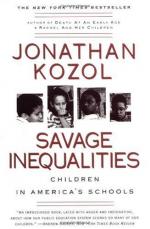
|
| Name: _________________________ | Period: ___________________ |
This test consists of 5 multiple choice questions, 5 short answer questions, and 10 short essay questions.
Multiple Choice Questions
1. Why did the city of Chicago construct the high-speed Dan Ryan Expressway to go around certain parts of the city?
(a) To avoid sections of the city that were not highly populated.
(b) To only service those living in the suburbs, but working in downtown Chicago.
(c) To cut off the section of the city that houses the housing projects for black people.
(d) To cut off the industrial sections of the city.
2. What is the dropout rate for Woodrow Wilson High School?
(a) 68%.
(b) 58%.
(c) 72%.
(d) 80%.
3. What are two of the problems that Vernon Dover, principal of Pyne Point Junior High, tells Kozol exist at his school?
(a) Dropouts and space.
(b) Low enrollment and traunt students.
(c) Dropouts and low teacher salaries.
(d) Low teacher salaries and space.
4. What is one way Jonathan Kozol says can show people how valuable we think they are?
(a) By the textbooks that are in the classrooms at the school.
(b) By the number of social workers assigned to a school.
(c) By the amount of welfare they receive.
(d) By the medical care we offer them.
5. Where is Camden ranked in terms of its number of poor people as compared to other states in the U.S.?
(a) Fourth.
(b) Third.
(c) Second.
(d) First.
Short Answer Questions
1. After speaking to the kindergarten class at PS79, Kozol learns that one of the African-American boys in the class travels how long each day to get to school?
2. What does the principal at PS79 say he will have to do if more students enroll at his school?
3. What is the fate of Raymond Abbot long after the court's decision is rendered?
4. How long do some of the students at Morris High School think it will be before blacks and whites work together to better public education?
5. According to Thurston, why are poor people in Washington, D.C. willing to accept a dual system of public education?
Short Essay Questions
1. How do the suburban schools in New York compare to the urban schools in New York?
2. What three Supreme Court justices wrote dissents for the Milliken v. Bradley case? Why did each dissent?
3. How does the judge respond to the class-action suit filed by the parent's of Raymond Abbot?
4. What problems do highly selective schools create in New York? Why do they create these problems?
5. Why does Kozol think that inner city problems would not be totally solved by better schools?
6. Where does Delabian Rice-Thurston say the rich and middle class in Washington, D.C. try to send their children to school? Why don't the poor parents send their children to the same schools?
7. Describe PS 261.
8. What similarity exist between selective schools in New York and Chicago?
9. Why would the students at Woodrow Wilson High want to remain there rather than attending a school with better resources?
10. Who is Joe Clark? What role did he play in the New Jersey public school system?
|
This section contains 1,441 words (approx. 5 pages at 300 words per page) |

|




